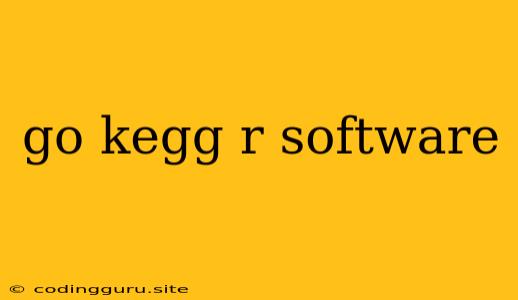Delving into the World of KEGG: A Comprehensive Guide to GO and R Software
The world of bioinformatics is vast and complex, and often requires specialized tools to unravel the intricacies of biological data. KEGG, or Kyoto Encyclopedia of Genes and Genomes, stands as a pivotal resource in this field, providing a comprehensive database of biological pathways, enzymes, and genes. Two critical elements in utilizing KEGG effectively are GO (Gene Ontology) and R software. Let's dive deeper into each of these aspects and understand how they work together to empower your bioinformatics endeavors.
What is KEGG and Why is it Essential?
KEGG serves as a central repository for understanding the complex relationships within biological systems. Imagine it as a detailed map of interconnected pathways, each representing a specific biological process. Whether you're studying metabolism, disease pathways, or gene interactions, KEGG provides a framework to organize and interpret your data.
The Importance of GO in KEGG Analysis
GO, or Gene Ontology, provides a standardized vocabulary for describing the functions of genes and proteins. It's like a universal language for understanding biological processes, allowing researchers to compare and analyze data across different studies. Within KEGG, GO terms are associated with various pathways and enzymes, providing valuable context for your analysis.
How Does GO Help in KEGG?
- Enrichment Analysis: GO enrichment analysis helps identify the most relevant GO terms associated with a set of genes or proteins you're studying. This helps you understand the biological processes that are most likely affected by the genes you're examining.
- Pathway Visualization: KEGG maps can be enhanced with GO information, providing a more comprehensive view of pathways and highlighting key functions within each pathway.
R Software: Your Powerful Tool for KEGG Analysis
R software is a versatile and open-source language designed specifically for statistical computing and data visualization. Its powerful packages, such as KEGGREST and pathview, are tailored to work seamlessly with KEGG data.
How R Makes KEGG Analysis Easier:
- Data Access: KEGGREST allows you to directly access and retrieve data from KEGG, streamlining your workflow and eliminating manual data extraction.
- Visualization: pathview enables you to create visually appealing pathway maps, incorporating GO information and highlighting significant differences in your data.
- Analysis: R provides a powerful platform for conducting statistical analyses on KEGG data, allowing you to identify trends, patterns, and statistically significant differences.
Harnessing the Power of GO and R with KEGG
Imagine you're studying a set of genes involved in a particular disease. Using KEGG, you can map these genes to specific pathways and understand their roles. Applying GO enrichment analysis, you can identify the most relevant biological processes associated with these genes. R, with its dedicated packages, provides the tools to extract this data, visualize it on pathway maps, and conduct further statistical analysis.
Example: Unraveling Metabolic Pathways with GO and R
Consider a study focusing on metabolic disorders. You have a list of genes that are differentially expressed in individuals with the disorder. Using KEGG, you map these genes to relevant metabolic pathways. GO enrichment analysis reveals a significant enrichment of GO terms related to carbohydrate metabolism. R can then be used to visualize these pathways, highlighting the altered genes and their connections within the metabolic network.
Tips for Utilizing GO and R with KEGG
- Start with Clear Objectives: Define your research question or hypothesis before diving into KEGG analysis.
- Choose the Right Packages: Select R packages specific to your needs, whether it's data retrieval, visualization, or statistical analysis.
- Understand GO Terminology: Familiarize yourself with GO terms and their hierarchical structure to effectively interpret your results.
- Don't Forget the Data: Ensure your data is appropriately formatted and ready for analysis within R.
Conclusion
KEGG is a powerful tool for navigating the complexities of biological systems. When combined with GO and R software, it unlocks a world of insights, allowing researchers to gain deeper understanding of biological processes and drive their research to new heights. By utilizing the synergy between these three components, you can effectively explore gene functions, analyze pathways, and ultimately contribute to the advancement of bioinformatics research.
